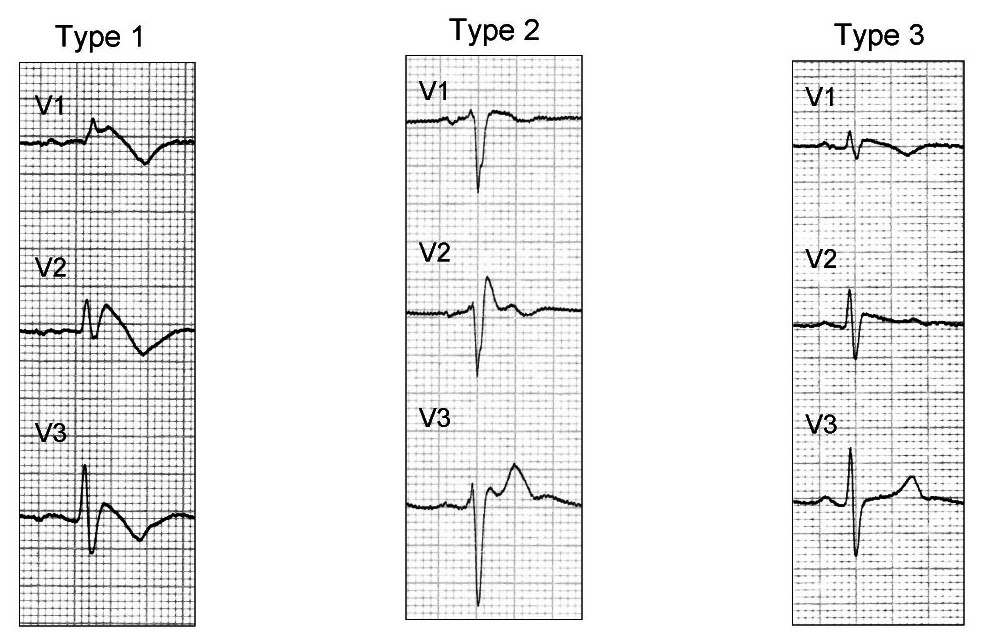Brugada syndrome classification
|
Brugada syndrome Microchapters |
|
Diagnosis |
|---|
|
Treatment |
|
Case Studies |
|
Brugada syndrome classification On the Web |
|
American Roentgen Ray Society Images of Brugada syndrome classification |
|
Risk calculators and risk factors for Brugada syndrome classification |
Editor-In-Chief: C. Michael Gibson, M.S., M.D. [1] Associate Editor(s)-in-Chief: Sogand Goudarzi, MD [2]
Overview
There are three electrocardiographic patterns associated with Brugada syndrome: Type I, Type II and Type III. The diagnosis of Brugada syndrome is based upon the presence of Type I EKG changes. Patients with Type II or Type III Brugada patterns can convert to a Type I Brugada pattern following the administration of sodium channel blockers such as ajmaline and flecainide. To be classified as having Brugada syndrome (not just the pattern), one or more of the following criteria must also be met:
- Family history of sudden cardiac death (SCD) (<45 years old)
- Documented ventricular fibrillation (VF)
- Polymorphic ventricular tachycardia
- Coved-type ECG changes in family members
- Inducibility of ventricular tachycardia (VT) with programmed electrical stimulation (PES)
The patient is also diagnosed as having Brugada syndrome when a Type 2 (saddleback pattern) or Type 3 ST-segment elevation is observed in more than one right precordial lead under baseline conditions that can be converted to the diagnostic Type 1 Brugada pattern following administration of a sodium channel blocker and the clinical criteria listed above are met as well.
Classification
- There are three types of electrocardiogram patterns that are seen in Brugada syndrome; Type I, Type II, and Type III. Type I Brugada syndrome may always be present on the EKG, or it may be elicited by the administration of particular drugs (e.g., Class IC antiarrythmic drugs that blocks sodium channels such as ajmaline, flecainide) or it may be unmasked by various triggers or risk factors.[1]
- Type I Brugada pattern is characterized by ST elevations in leads V1-V3 with a right bundle branch block (RBBB). A prolongation of the PR interval is also frequently seen. The EKG changes of Brugada syndrome can vary over time, depending on the autonomic balance and the administration of antiarrhythmic drugs. Adrenergic stimulation decreases the ST segment elevation, while vagal stimulation worsens it. The administration of class Ia, Ic and III drugs increases the ST segment elevation, as does fever.[2][3]
- Exercise decreases ST segment elevation in some patients but increases it in others (after exercise when the body temperature has risen). The changes in heart rate induced by atrial pacing are accompanied by changes in the degree of ST segment elevation. When the heart rate decreases, the ST segment elevation increases and when the heart rate increases the ST segment elevation decreases.[4]
- The three patterns of Brugada syndrome (Type I,II,III) are shown below:

The table below is from ECG pedia and is adapted from Wilde et al.[5]
| Type I | Type II | Type III | |
|---|---|---|---|
| J wave amplitude | >= 2mm | >= 2mm | >= 2mm |
| T wave | Negative | Positive or biphasis | Positive |
| ST-T configuration | Coved type | Saddleback | Saddleback |
| ST segment (terminal portion) | Gradually descending | Elevated >= 1mm | Elevated < 1mm |
References
- ↑ Tse, Gary; Liu, Tong; Li, Ka H. C.; Laxton, Victoria; Chan, Yin W. F.; Keung, Wendy; Li, Ronald A.; Yan, Bryan P. (2016). "Electrophysiological Mechanisms of Brugada Syndrome: Insights from Pre-clinical and Clinical Studies". Frontiers in Physiology. 7. doi:10.3389/fphys.2016.00467. ISSN 1664-042X.
- ↑ Brugada J, Brugada P, Brugada R (October 2001). "Brugada syndrome: the syndrome of right bundle branch block, ST segment elevation in V1 to V3 and sudden death". Indian Pacing Electrophysiol J. 1 (1): 6–11. PMC 1569891. PMID 17006566.
- ↑ Antzelevitch, Charles; Yan, Gan-Xin; Ackerman, Michael J.; Borggrefe, Martin; Corrado, Domenico; Guo, Jihong; Gussak, Ihor; Hasdemir, Can; Horie, Minoru; Huikuri, Heikki; Ma, Changsheng; Morita, Hiroshi; Nam, Gi-Byoung; Sacher, Frederic; Shimizu, Wataru; Viskin, Sami; Wilde, Arthur A.M. (2016). "J-Wave syndromes expert consensus conference report: Emerging concepts and gaps in knowledge". Europace: euw235. doi:10.1093/europace/euw235. ISSN 1099-5129.
- ↑ García-Fuertes, Daniel; Villanueva-Fernández, Elena; Crespín-Crespín, Manuel; Puchol, Alberto; Pachón, Marta; Arias, Miguel Angel (2016). "Type 1 Brugada Pattern Unmasked During the Recovery Period of an Exercise Stress Test". Arquivos Brasileiros de Cardiologia. doi:10.5935/abc.20160071. ISSN 0066-782X.
- ↑ Wilde AA, Antzelevitch C, Borggrefe M, Brugada J, Brugada R, Brugada P, Corrado D, Hauer RN, Kass RS, Nademanee K, Priori SG, Towbin JA (2002). "Proposed diagnostic criteria for the Brugada syndrome: consensus report". Circulation. 106 (19): 2514–9. PMID 12417552. Retrieved 2012-10-14. Unknown parameter
|month=ignored (help)